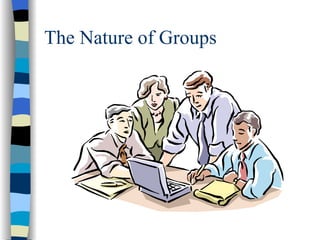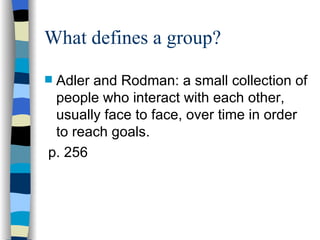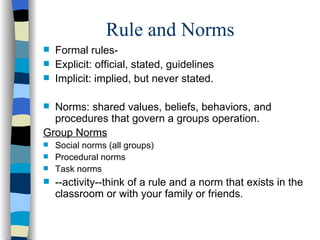1 groups.pp tintroductionroles_hoffman
- 1. The Nature of Groups
- 2. What defines a group? Adler and Rodman: a small collection of people who interact with each other, usually face to face, over time in order to reach goals. p. 256
- 3. GroupsŌĆ” Interact Are interdependent Last over time Small- 3+ goals
- 4. All the people in a groupŌĆ” 1. Are aware of each other 2. Share an interdependent purpose 3. Have a sense of belonging 4. Interact with one another 5. Accept the norms Norms are the expectations of the group
- 5. According to the previous definition, which are groups and which are not? 7 people riding in a train? No 3 boys playing with a softball? Yes Two police officers and a robber? No 5 members in a family? Yes
- 6. Group verses Individual Which is better? It depends on the situation. 1. Problem solving 2. Efficiency 3. Learning 4. Creativity 5. Motivation
- 7. Rule and Norms Formal rules- Explicit: official, stated, guidelines Implicit: implied, but never stated. Norms: shared values, beliefs, behaviors, and procedures that govern a groups operation. Group Norms Social norms (all groups) Procedural norms Task norms --activity--think of a rule and a norm that exists in the classroom or with your family or friends.
- 8. Activity
- 9. Rolls Rolls: define patterns of behavior expected of members Formal rolls ŌĆō assigned by an organization or group partly to establish order. Informal rolls- rarely acknowledged Task rolls-help the group accomplish its goals Social rolls- help the relationships among members run smoothly Dysfunctional rolls- prevent a group from working effectively
- 10. Deviance Violation of norms - norms and rules are maintained through group pressure - little tolerance= remove member or punished.
- 11. Perception and Rolls Our perceptions will shape what roll we think we play as well as what rolls others play Status: something that is perceived and given by other members -communication skills effect how others perceive your status
- 12. ╠²












